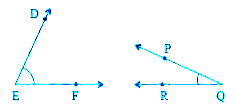Draw an angle and label it as ∠BAC. Construct another angle, equal to ∠BAC.
Step-by-Step Solution
1. Draw the First Angle:
- Start by drawing a horizontal line using a ruler. This line will serve as one side of the angle.
- Choose a point on this line and label it as point A.
- Using a protractor, place the center point of the protractor at point A and align one side of the protractor with the line you just drew.
- Measure 60 degrees on the protractor and mark a point at this measurement. Label this point as C.
- Draw a line from point A to point C. This line forms the second side of the angle.
- Label the angle as ∠BAC.
2. Construct the Equal Angle:
- To construct another angle equal to ∠BAC, start by drawing another horizontal line, and label a point on this line as point B.
- Using a compass, set a fixed width (you can choose any width, but it should be the same for both angles).
- Place the compass pointer on point A and draw an arc that intersects both sides of the angle ∠BAC. Label the intersection points as D and E.
- Without changing the compass width, place the compass pointer on point B and draw an arc above the line. Label this arc's intersection points as F and G.
- Now, using the compass, measure the distance between points D and E (the arc you drew from point A).
- Keeping the same compass width, place the compass pointer on point F and draw an arc that intersects the arc drawn from point B. Label this intersection point as H.
- Draw a line from point B to point H. This line forms the second side of the angle.
- Label this angle as ∠BAC'.
3. Verify the Angles:
- You can check that both angles ∠BAC and ∠BAC' are equal by measuring them with a protractor. They should both measure 60 degrees.
- Start by drawing a horizontal line using a ruler. This line will serve as one side of the angle.
- Choose a point on this line and label it as point A.
- Using a protractor, place the center point of the protractor at point A and align one side of the protractor with the line you just drew.
- Measure 60 degrees on the protractor and mark a point at this measurement. Label this point as C.
- Draw a line from point A to point C. This line forms the second side of the angle.
- Label the angle as ∠BAC.
- To construct another angle equal to ∠BAC, start by drawing another horizontal line, and label a point on this line as point B.
- Using a compass, set a fixed width (you can choose any width, but it should be the same for both angles).
- Place the compass pointer on point A and draw an arc that intersects both sides of the angle ∠BAC. Label the intersection points as D and E.
- Without changing the compass width, place the compass pointer on point B and draw an arc above the line. Label this arc's intersection points as F and G.
- Now, using the compass, measure the distance between points D and E (the arc you drew from point A).
- Keeping the same compass width, place the compass pointer on point F and draw an arc that intersects the arc drawn from point B. Label this intersection point as H.
- Draw a line from point B to point H. This line forms the second side of the angle.
- Label this angle as ∠BAC'.
- You can check that both angles ∠BAC and ∠BAC' are equal by measuring them with a protractor. They should both measure 60 degrees.
Topper's Solved these Questions
Similar Questions
Knowledge Check
In a triangle ABC, IF angle B is twice angle C then c (b +a) is equal to
Aa2Bb2Cc2DabcLet ABC be a triangle such that ∠A=45∘,∠B=75∘, then a+c√2 is equal to
A2aB2a+1C3aD2a-1
Draw a neat labelled diagram for the construction of 'cyclotron '.
View SolutionDraw a right angle and construct its bisector.
View SolutionDraw an angle of 65∘ and draw an angle equal to this angle, using ruler and compasses.
View SolutionDraw an angle equal to the difference of two angles given in Fig.

View SolutionDraw an angle of 80∘ with the help of protractor . Then, construct angles of (i)40∘(ii)160∘and(iii)120∘ .
View SolutionDraw an angle of 80∘ using a protractor and divide it into four equal parts, using ruler and compasses.Check your construction by measurement.
View Solution